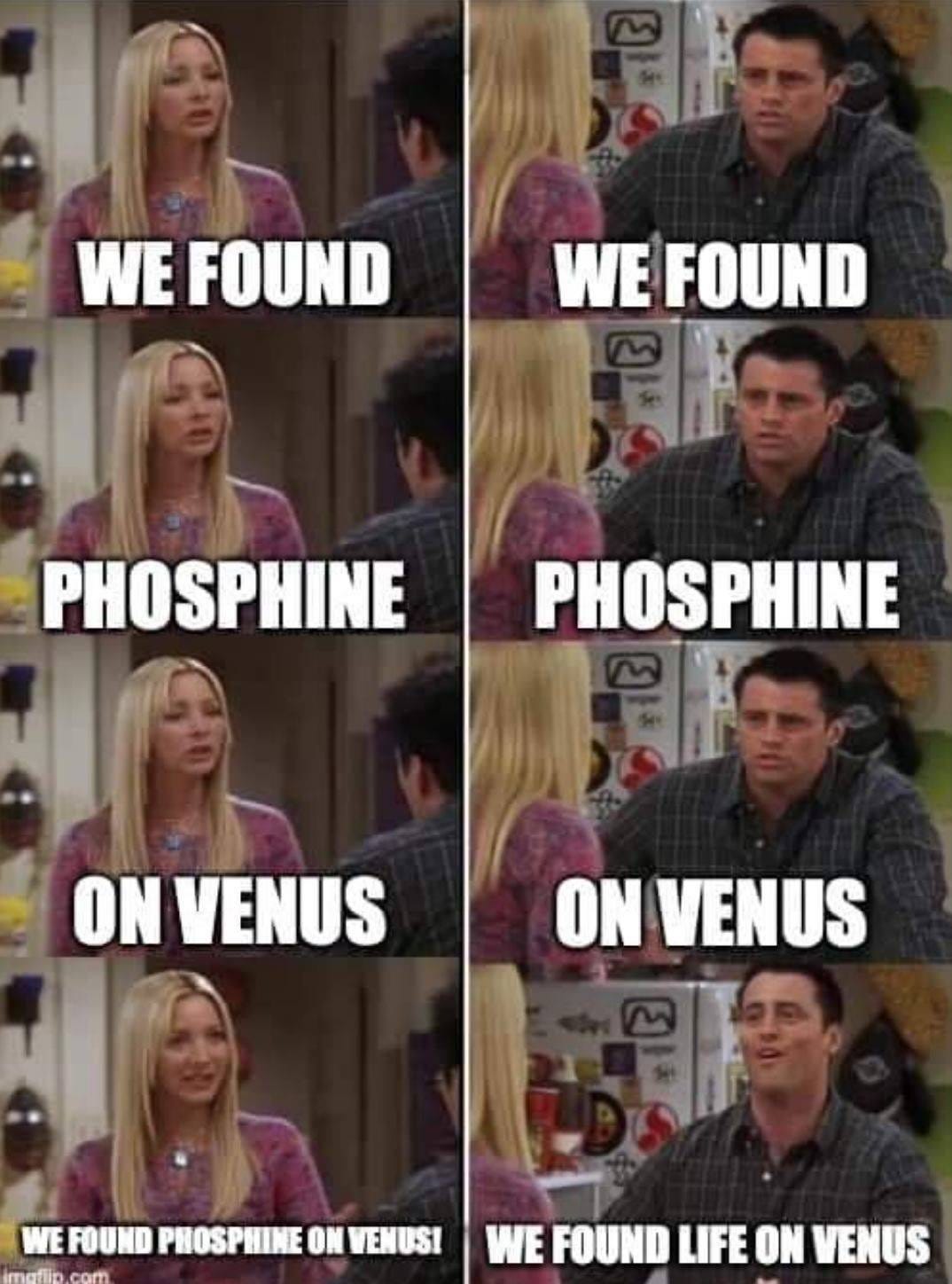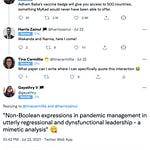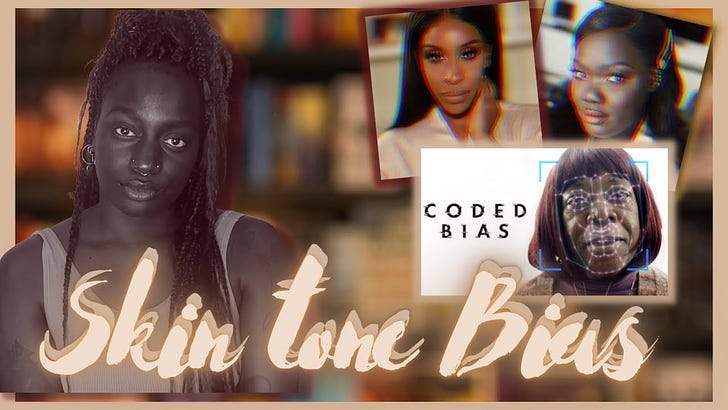Round and round we go
Sarah Manavis for New Statesman: Why Goodreads is bad for books. Launched in 2007 and bought by Amazon in 2013, the book site never had a serious contender.
Kate Klonick for The Atlantic: I study online-speech rules for a living. And then my own account was suspended. What one law professor learned from her time in Twitter purgatory.
Echo Wang and Greg Roumeliotis for Reuters: Oracle beat Microsoft in TikTok deal. It’s not a purchase, it’s a partnership.
Sarah Perez for Tech Crunch: Facebook launched… Facebook? Students need .edu emails to register for Facebook Campus. Déjà vu much?
Phosphine
A meme that made its round on the Internet this week
Trace levels of phosphine, about 20 molecules per billion, was detected in Venus’ atmosphere. The detections were made in 2017 with the James Clerk Maxwell Telescope in Hawaii and in 2019 with the Alma Telescope in Chile. The team was led by Jane Greaves, Cardiff University astronomer.
The presence of phosphine is considered by most astrobiologists as the biosignature (or bioindicator or biomarker) of the possible presence of life. The compound isn’t complex: a phosphorus atom attached to three hydrogen atoms, PH3. It smells like sewage and is highly toxic to humans.
Phosphine is currently known to be produced in several ways:
industrial processes, such as in the use of pesticides
a result of geophysical activities, such as a volcanic eruption
released by certain microbes in oxygen-deprived environments
Because there are no known industrial activities or labs in Venus, chances are, that is not the cause for the presence of phosphine in Venus.
And while it is possible that volcanic eruptions or even lightning might have contributed to the presence of phosphine in Venus, they would produce about 1,000 times too little than what was detected, explained Paul Rimmer, an astrochemist on the team at the University of Cambridge to The Guardian.
Still, the authors wrote in the paper: “Even if confirmed, we emphasise that the detection of PH3 is not robust evidence for life, only for anomalous and unexplained chemistry.”
Venus is considered Earth’s sister planet for our share similar size and mass. The gas was found not on the surface of the planet but rather its atmosphere, specifically 53-62km above its surface. While the planet’s atmosphere is inhospitable to humans for its extremely high temperatures and pressures, and the clouds contain 90 per cent sulphuric acid, this particular altitude layer is a little bit less brutal, and in fact, comparable to the temperatures and pressure of the surface of Earth.
Reports & Retorts
And here’s how some publications wrote about it:
“Signs of alien life detected on Venus,” reported Sky News.
“Likelihood of life on Venus just increased dramatically,” reported Airspace Mag.
“Possible signs of alien life discovered on Venus,” reported The Independent.
I am a member of a virtual astrobiology society, having taken a course on the subject with the University of Edinburgh’s professor of astrobiology Charles Cockell several years ago. The group went abuzz:
Caryn O’Keefe: “The operative phrase is anomalous and unexplained chemistry.”
Thomas Fieselmann: “From one detected absorption line to the possibility of life is a big logical jump.”
Martyn Fogg: “I’m squeamish about hype over minute amounts of trace gases, given our incomplete knowledge of the photo- and geochemistry of other worlds. […] You get a pulse of hype, then it dies down rapidly as it becomes obvious that the situation regarding the actual discovery of extraterrestrial life has not changed. Memories of hype episodes in the past that led to nothing (most of them) are always tinged with faint embarrassment, leading one to ask, ‘Was the hype justified in the first place or have the possible implications just been sexed up out of proportion?’”
Mars Parallels
Indeed it’s not the first time we’ve read reports like this: An experiment in the 70’s detected chemical reactions in the soil of our other planetary neighbour, Mars, that were said to show signs that the planet did contain life.
And then, the presence of methane was reported in the atmosphere of Mars in 2004. Possible sources of methane are either geophysical or biogenic in nature. Decades later, we’ve heard nothing more.
Rushing Russians
From The Guardian: [Cockell said] rather than hinting at life on Venus, the work raises questions about phosphine as a biomarker. A biological explanation should always be the explanation of last resort and there are good reasons to think the Venusian clouds are dead. The concentrations of sulphuric acid in those clouds are more extreme than any known habitat on Earth.
So the early finding means more efforts to follow up with further observations perhaps with atmospheric probes flying through the deathly Venusian clouds.
The race has begun. Dmitry Rogozin, the head of Russia’s space agency, has already staked a claim, announcing “Venus is a Russian planet,” because the first missions to explore Venus was carried out by the then Soviet Union. The last time they were there was in the 1980s when the Venera space probes were launched to the planet. Ten probes landed on the planet’s surface and thirteen successfully entered the Venusian atmosphere, setting key precedents in space explorations:
Venera 3 was the first human-made device to enter another planet’s atmosphere
Venera 7 was the first human-made device to make a soft landing on another planet
Venera 9 was the first human-made device to return images of another planet’s surface
Venera-D is expected to launch in 2026 and 2031.
What I read, watch and listen to…
I’m reading A Mathematician’s Lament, an essay by Paul Lockhart.
I’m watching RBG. RIP.
Chart of the week
Malaysia surpassed 10,000 COVID-19 cases on September 16th, the spike contributed largely by a prison cluster in Sabah. Meanwhile, the state election will take place on September 26th after a political crisis led the (now caretaker) chief minister to dissolve the state legislative assembly.
Apa itu MA63? Dan Kenapa ia Penting Bagi Sabah dan Sarawak – New Naratif
Artikel ini ditulis oleh Vila Somiah, dilukis oleh Timothy James dan disunting oleh Charis Loke dan Deborah Augustin untuk New Naratif. Saya melakukan terjemahan dari bahasa Inggeris ke bahasa Melayu. Artikel asal juga boleh didapati di pautan ini.
Seperti ramai rakan sekerja di industri media sedia maklum, saya sering kali tidak berpuas hati dengan cara Sabah dan Sarawak digambarkan di dalam media, terutamanya menjelang bulan-bulan Jun sehingga September. Tapi inilah cara untuk melakukannya dengan betul dan baik sekali.
Saya gembira dapat menyumbang sedikit dalam usaha ini. Ini sebenarnya kali pertama saya terlibat secara langsung dalam mana-mana penerbitan mengenai hari Malaysia, kerana saya biasanya menolak tugasan berkaitan dengannya kerana sudah bertahun-tahun bersumpah tidak mahu bersubahat dalam sebarang cubaan untuk meremeh-temehkan atau mengeksploitasikan Sabah dan Sarawak di dalam media. Ini lain, ini istimewa.














